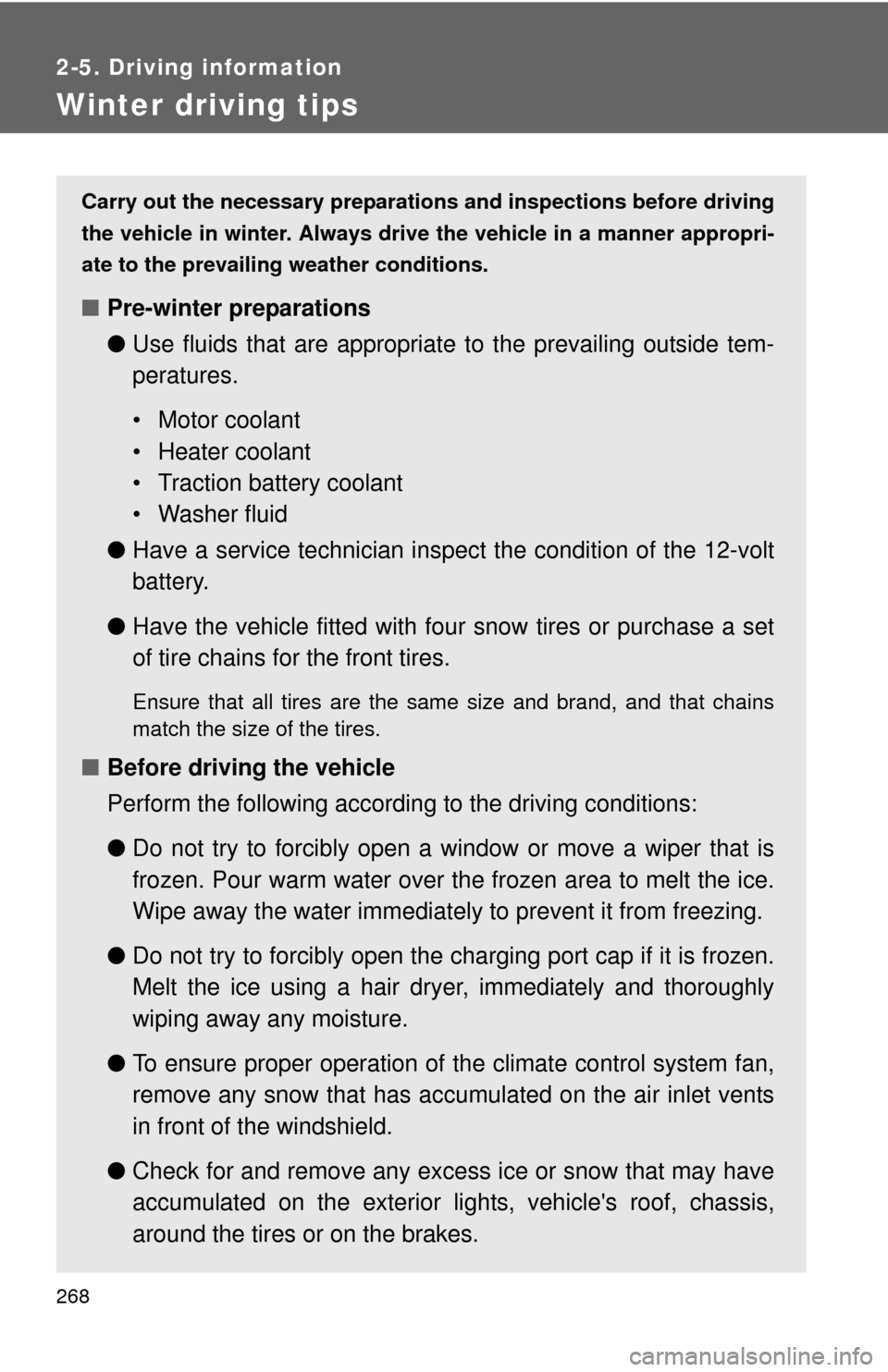Page 261 of 520

261
2-5. Driving information
2
When driving
CAUTION
■
Off-road driving precautions
Always observe the following precautions to minimize the risk of serious per-
sonal injury or damage to your vehicle:
●Drive carefully when off-road driving is unavoidable. Do not take unneces-
sary risks by driving in dangerous places.
● Do not grip the steering wheel spokes when off-road driving is unavoid-
able. A bad bump could jerk the wheel and injure your hands. Keep both
hands and especially your thumbs on the outside of the rim.
● Always check your brakes for effectiveness immediately after driving in
sand, mud, water or snow.
● When it is unavoidable to drive through tall grass, mud, rock, sand, etc.,
take care not to damage the traction batteries equipped under the floor.
After driving through such terrain, check that there is no grass, bush,
paper, rags, stone, sand, etc. adhering or trapped on the underbody. Clear
off any such matter from the underbody. If the vehicle is used with these
materials trapped or adhering to the underbody, a breakdown or fire could
occur.
● When driving off-road is unavoidable, do not drive at excessive speeds,
jump, make sharp turns, strike objects, etc. This may cause loss of control
or vehicle rollover causing death or serious injury. You are also risking
expensive damage to your vehicle’s suspension, chassis, drive unit or the
traction batteries.
Page 268 of 520

268
2-5. Driving information
Winter driving tips
Carry out the necessary preparations and inspections before driving
the vehicle in winter. Always drive the vehicle in a manner appropri-
ate to the prevailing weather conditions.
■ Pre-winter preparations
●Use fluids that are appropriate to the prevailing outside tem-
peratures.
• Motor coolant
• Heater coolant
• Traction battery coolant
• Washer fluid
● Have a service technician inspec t the condition of the 12-volt
battery.
● Have the vehicle fitted with four snow tires or purchase a set
of tire chains for the front tires.
Ensure that all tires are the same size and brand, and that chains
match the size of the tires.
■Before driving the vehicle
Perform the following according to the driving conditions:
●Do not try to forcibly open a window or move a wiper that is
frozen. Pour warm water over the frozen area to melt the ice.
Wipe away the water immediately to prevent it from freezing.
● Do not try to forcibly open the charging port cap if it is frozen.
Melt the ice using a hair dryer, immediately and thoroughly
wiping away any moisture.
● To ensure proper operation of th e climate control system fan,
remove any snow that has accumulated on the air inlet vents
in front of the windshield.
● Check for and remove any excess ice or snow that may have
accumulated on the exterior li ghts, vehicle's roof, chassis,
around the tires or on the brakes.
Page 289 of 520
289
3-1. Using the air conditioning system
and defogger
3
Interior features
■If the amount of charge remaining in the traction battery becomes low
Depending on the battery’s condition, the air conditioning system’s usage
may be restricted or stopped (excluding the windshield defogger). If the air
conditioning is restricted or turned off, one of the following messages will be
shown on the HVAC display.
Warning messageDetails
(Shown for a few seconds) Climate Control Power possibly
limited.
• The traction battery output is low.
Any climate control setting can be
selected.
(Shown continually) Climate Control Power stopped.
• The traction battery level is very low.
• The traction battery output is very low.
Only the windshield defogger and
rear window defogger can be
selected.
(Shown for a few seconds) Climate Control Power possibly
limited.
• The traction battery temperature is high.
Some climate control setting can-
not be selected.
Page 389 of 520
389
4-3. Do-it-yourself maintenance
4
Maintenance and care
Fuse layout and amperage ratings
■ Motor compartment
Type A (driver’s side)
FuseAmpereCircuit
1 INV MTR 10 A Inverter motor
2 IGDI 1 10 ATraction battery, multiplex commu-
nication system, thermal control
system
3 BATT W/P 1 15 A Traction battery
4 BATT W/P 2 15 A Traction battery
5 P/T W/P 15 A Cooling system
6 IGDI MAIN 20 A INV MTR, IGDI 1
7 HAZ 15 A Emergency flashers
8 IGCT 3 20 APM-IGCT, P CNT-IGCT, A/C-IGCT,
FA N -I G C T
9 G/W-B 10 A Multiplex communication system
10 RADIO 30 A Audio system
11 P CNT-B 7.5 A Parking control system
Page 390 of 520
390 4-3. Do-it-yourself maintenance
12 ABS 130 A Anti-lock brake system
13 ECB 1 50 AElectronically controlled brake sys-
tem
14 ECB 2 50 AElectronically controlled brake sys-
tem
15 W/P-IGCT 50 A P/T W/P, BATT W/P 1, BATT W/P 2
16 EPS 60 A Electric power steering
17 P/I 60 AIGCT-D, HORN, parking control
system, IG2
18 MAIN 60 AH-LP MAIN, DRL, ODS, smart key
system, ABS 2, steering lock sys-
tem, PM-B, ECU-B MAIN
19 CONTACTOR 15 A Traction battery, charging system
20 IG2 15 A Starting system
21
HORN 10 A Horn
22 IGCT-D 7.5 A Thermal control system, power
management ECU, parking control
system, multiplex communication
system
23 PM-IGCT 7.5 A Power management system
24 P CNT-IGCT 7.5 A Parking control system
25 A/C-IGCT 10 A Air conditioning system
26 FAN-IGCT 7.5 A Electric cooling fans
FuseAmpereCircuit
Page 419 of 520

5
When trouble arises
419
5-2. Steps to take in an emergency
Follow the correction procedures.
After taking the specified steps to correct the suspected problem,
check that the warning light goes off.
(Yellow) Brake system warning light
Indicates a malfunction in:
• The regenerative brake system; or
• The electronically controlled brake system
(Flashing) Cruise control indicator light
Indicates a malfunction in the cruise control system
Warning lightWarning light/DetailsCorrection procedure
Open door warning light
(warning buzzer)*
1
Indicates that a door or
the trunk is not fully
closed Check that all the doors
are closed.
SOC (State of Charge)
warning light The amount of charge
remaining in the traction
battery has fallen to the
SOC gauge’s 2 lowest
segments Charge the vehicle.
(Yellow) Plug-in indicator
Indicates a malfunction
with the charging cable. Reconnect the charging
cable.
If the warning light
does not go off even
after reconnecting the
charging cable, contact
your Toyota dealer.
Warning lightWarning light/Details
Page 420 of 520
420 5-2. Steps to take in an emergency
(Flash quickly)Charging indicator
Indicates a malfunction in
the charging system
P. 5 9
Output control warning
light (warning buzzer) EV system power avail-
able is low (due to the
amount of charge remain-
ing in the traction battery
being low, or low temper-
ature or high tempera-
ture) Charge the vehicle.
Seat belt reminder light
(warning buzzer)*
2
Warns the driver/front
passenger to fasten his/
her seat belt. Fasten the seat belt.
Master warning light A buzzer sounds and the
warning light comes on
and flashes to indicate
that the master warning
system has detected a
malfunction.
P. 4 2 7
Warning lightWarning light/DetailsCorrection procedure
Page 493 of 520

493
6-1. Specifications
6
Vehicle specifications
■
Treadwear
The treadwear grade is a comparative rating based on the wear
rate of the tire when tested under controlled conditions on a speci-
fied government test course.
For example, a tire graded 150 would wear one and a half (1 - 1/2)
times as well on the government course as a tire graded 100.
The relative performance of tires depends upon the actual conditions
of their use, however, and may depart significantly from the norm due
to variations in driving habits, service practices and differences in
road characteristics and climate.
■ Traction AA, A, B, C
The traction grades, from highest to lowest, are AA, A, B and C,
and they represent the tire's ability to stop on wet pavement as
measured under controlled cond itions on specified government
test surfaces of asphalt and concrete.
A tire marked C may have poor traction performance.
Warning: The traction grade assigned to this tire is based on braking
(straight ahead) traction tests and does not include cornering (turn-
ing) traction.
■ Temperature A, B, C
The temperature grades are A (the highest), B, and C, represent-
ing the tire's resistance to the generation of heat and its ability to
dissipate heat when tested under controlled conditions on a speci-
fied indoor laboratory test wheel.
Sustained high temperature can cause the material of the tire to
degenerate and reduce tire life, and excessive temperature can lead
to sudden tire failure.
The grade C corresponds to a level of performance which all passen-
ger car tires must meet under the Federal Motor Vehicle Safety Stan-
dard No. 109.
Grades B and A represent higher levels of performance on the labo-
ratory test wheel than the minimum required by law.